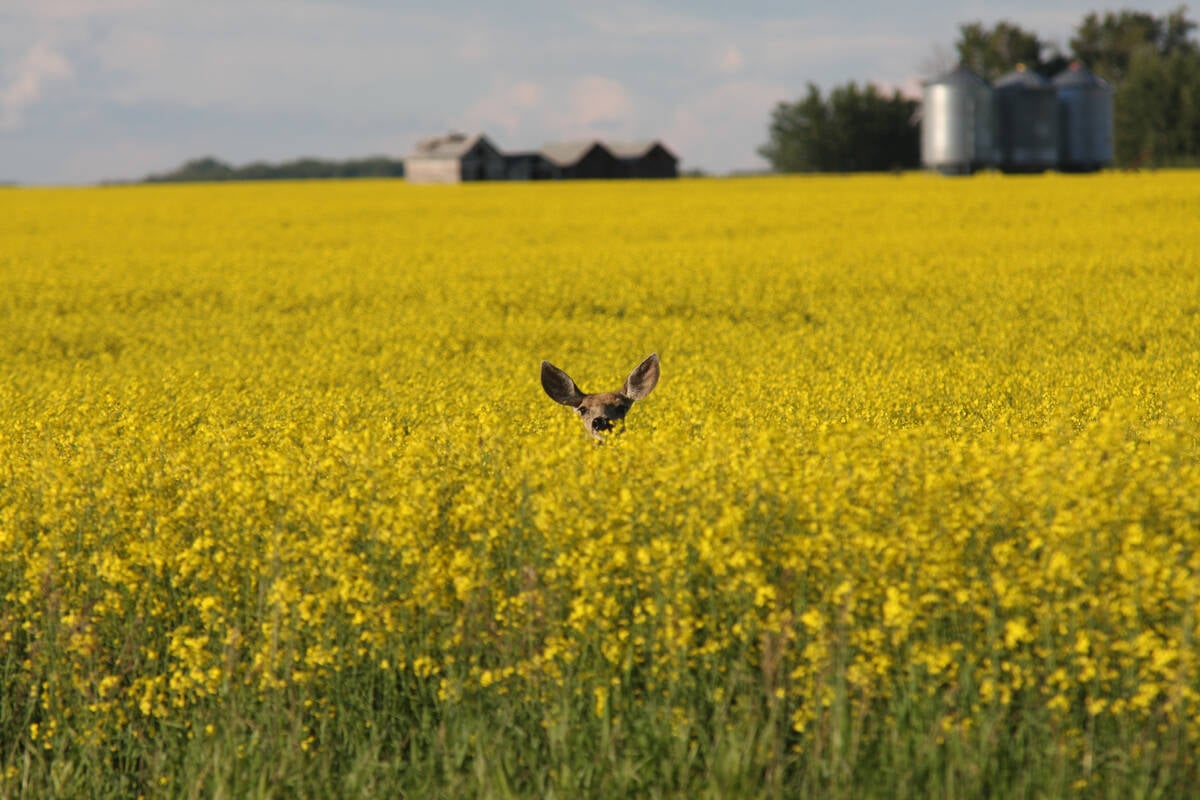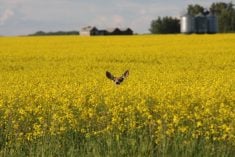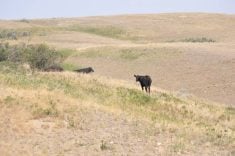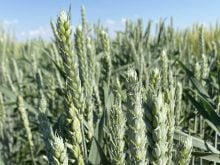STE. ROSE DU LAC, Man. – Life is often a story of compromises.
For instance, if an entrepreneur wants to run a successful business, it usually means less time for family, friends and fun.
But cattle producer Dean Gamache has found a way to increase profits on the farm and spend more time with his wife, Brenda, and their three children: Austin, 13, Delaney, 11 and Emma, 8.
Over the last decade, Dean and his father-in-law, Tony Guillas, have adopted innovative practices to reduce the labour and capital costs of running a 240-cow herd, including late calving, swath grazing, corn grazing, bale grazing and shortening the length of the breeding season.
Read Also

Drones now used to assess wildlife crop damage in Saskatchewan
Wildlife damage in Saskatchewan crops is now assessed by drones and artificial intelligence.
Those innovations, Dean said while sitting at his kitchen table on a cold but clear day in late February, have generated enough free time in the winter to allow him to coach hockey, play on an old-timers team and drive his kids to hockey games across Manitoba.
“In the winter time it’s really benefitted us because our kids can all play hockey. He and I can play hockey as well,” said Brenda, who sat down at the kitchen table for a few minutes after getting home from her job as a teacher in nearby Laurier, Man.
“Next week he’s going to go skiing with the kids and the school. If you had to feed cattle every day, you wouldn’t be able to do that.”
Dean runs a mixed herd, cow-calf operation on 2,500 acres southeast of Ste. Rose du Lac.
He describes it as a straight cattle farm, but he also grows 200 acres of barley, corn and rye.
The barley is grown for feed because Dean backgrounds 75 percent of his calves. The corn, typically 65 acres, is grown for grazing.
“We’ll graze (corn) from the beginning of December until the middle of January, roughly,” said Dean, who has been corn-grazing cattle since 2001.
“People ask me why don’t you do more… but the only reason is I don’t have the land (suitable for corn).”
Corn grazing is an example of Dean’s farm management philosophy, which he characterized as low input and low stress.
He said it doesn’t make sense to pay a custom operator hundreds of dollars per hour to chop the corn into silage, store the silage and then take it out of the bin to feed to cattle.
Instead, why not let the cattle find their own food?
“We spent a lot of time collecting data on our costs and the profitability of it,” said Dean, who participated in a Manitoba Agriculture study that showed corn grazing is nearly 40 percent cheaper than feeding cattle bales of alfalfa.
“The less diesel and iron you have between the cow and the cow’s feed, the more profitable you are.”
Dean, who attends grazing schools and cattle producer seminars, said he usually takes away one key idea from a presentation, which he puts into action on his farm.
For instance, in the early 2000s a speaker at the Manitoba Grazing School said late calving made calving “a non-event” on the farm.
“That was the phrase that stuck with me,” Dean said.
Calving now starts April 29 on the Gamache farm and is approximately 80 percent done by May 12.
“It’s absolutely a non-event,” he said.
The only tricky part was convincing his father-in-law to make the switch. Fortunately, Dean has learned a trick or two when it comes to selling the older generation on change.
“I tell a lot of young guys if you have something you want to do, tell them (the older generation) the idea and let them shoot it down. Then let them think about it (for a year or more) and all of sudden they’ll remember it and then it’s their idea…. But don’t miss your chance to say, ‘yes, let’s try it.’ ”
The Gamaches had little or no intention of making a living on the farm when they got married in 1994.
“When I first went to university … I thought I would end up somewhere else, not around here,” said Brenda, who grew up in the farmhouse where she now lives.
Her parents, Tony and Marie-Ange, now reside in Ste. Rose.
“When I left (the farm), I never thought I would miss it, but I really did miss it. I’m glad that I came back, but I joke with my friends that I never dreamed I’d be living in my mom’s house.”
Dean grew up in Laurier, but his uncles and grandparents operated mixed farms in the region and he spent a great deal of his childhood operating tractors, driving trucks and helping out with livestock.
He studied business administration at Red River College in Winnipeg and took a job with the TD Bank.
However, he quickly realized that a career in finance wasn’t for him.
“We had to decide whose career path we were going to follow…. We came back here and Brenda continued on teaching…. I worked on farms in the area.”
For several years he worked for his father-in-law in winter and on a grain farm in summer.
Eventually, Dean and Tony began talking about the transfer of farm ownership, which can be stressful for farm families.
However, a provincial government program to assist producers with intergenerational farm transfers made the process easier.
“It’s a conversation that no one wants to have,” Dean said. “(But) it was basically us sitting down at a table with a third party…. and seeing what other people were doing (regarding farm transfer).”
That conversation occurred in the 1990s and it wasn’t until this year that Tony truly backed away from the cattle operation, when he and Marie-Ange spent a few months of the winter in Texas.
Dean said the gradual transition has worked out well for both generations.
“To be honest, it probably took us 12 years to work through it. There wasn’t any big rush. We weren’t interested in pushing anyone out,” he said. “That’s been OK with us.”















